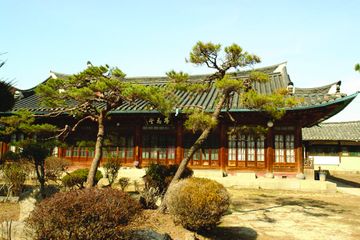학인당
| 학인당 Hagindang House |
|
 학인당, 국가문화유산포털, 문화재청. |
|
| 대표명칭 | 학인당 |
|---|---|
| 영문명칭 | Hagindang House |
| 한자 | 學忍堂 |
| 주소 | 전라북도 전주시 완산구 향교길 45 |
| 지정번호 | 시도민속문화재 제8호 |
| 지정일 | 1976년 4월 2일 |
| 분류 | 유적건조물/주거생활/주거건축/가옥 |
| 수량/면적 | 1동5필지(1,656.1㎡) |
| 웹사이트 | 학인당, 국가문화유산포털, 문화재청. |
|
|
|
해설문
국문
학인당은 대한제국 시기 효자로 알려진 백낙중(白樂中)이 살았던 집이다. 그의 호 인재(忍齋)의 ‘인’ 자를 따서 이름을 지었으며 압록강과 오대산 등지의 목재를 사용하여 1908년에 완공하였다.
집을 지을 때 고종은 경복궁 중건에 협력한 백낙중의 노고를 배려하여 궁궐의 목수를 보냈다고 한다. 건립 당시 99칸짜리 대저택이었으나 지금은 학인당과 부속건물 6채만 남아있다.
학인당은 조선 후기의 전통 건축기술을 이어받아 지은 한옥으로, 궁중 건축양식을 민간 주택에 도입한 사례로 평가받고 있다.
영문
Hagindang Hall
This house was used as the residence of Baek Nak-jung (1882-1930, pen name: Injae), a devoted son renowned for his filial piety during the Korean Empire (1897-1910).
Started in 1905 and completed in 1908, the house was originally a large mansion that was modeled on palace architecture. Today, only Hagindang Hall and six auxiliary buildings remain.
This house is equipped with electricity and tap water systems, which required highly advanced technology at the time of construction. The bifold external doors feature glass window panes, which are not traditional to Korean houses but became a common design element in the early 20th century. Liftable papered doors throughout the house facilitate the expansion of the indoor space to allow for large group seating for traditional performances such as pansori.
After 1945, the place was also used as a guest house to accommodate government officials.
- 백인제, 백인제 가옥과 관련이 있을까?
- 한상룡(1880, 1947, 이왕용 외조카), 1913 --> 1944 백인제 수요
- 압록강 흑송 - 1907년 경성박람회 때 흑송 목재가 소개된 바 있다. 백인제가옥 소개, 서울역사박물관
영문 해설 내용
대한제국 시기 효자로 알려진 백낙중(1882-1930)이 살았던 집이다.
궁중 건축양식을 사용해서 지은 민간 주택으로, 1908년에 완공하였다. 원래는 대저택이었으나 지금은 학인당과 부속건물 6채만 남았다.
당시로서는 첨단 시설인 전기 시설과 수도 시설도 설치되었다. 본채는 출입문을 떼어 판소리 공연을 할 수 있게 지어졌다. 광복 후에는 정부 요인들이 묵는 영빈관 역할을 하기도 했다.
참고
- "전주 백낙중 종가", 영남일보 위클리포유, 2015.06.04.